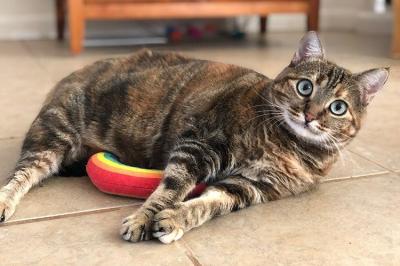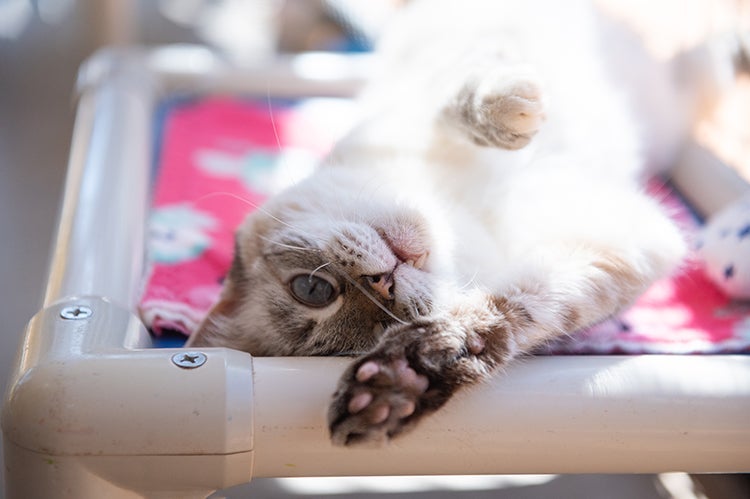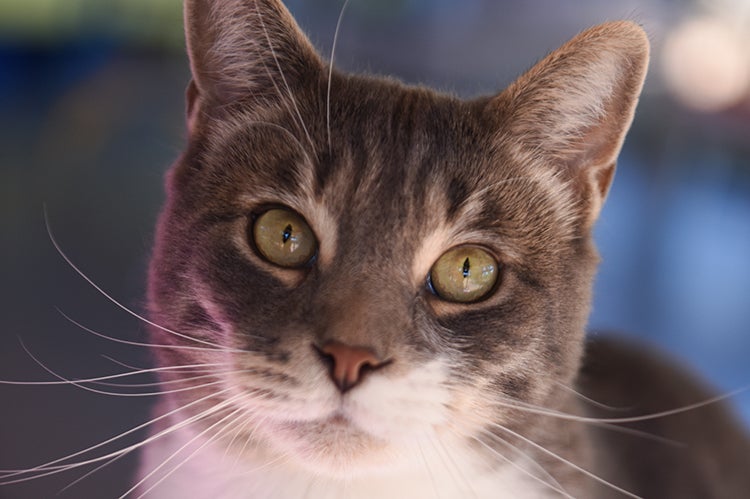
Caring for an Incontinent Cat
Bringing an incontinent cat into your home can be a wonderful and rewarding experience. The level of care needed varies widely, as does the level of messiness, so learning about the needs of an individual cat with incontinence is key to making a decision about adopting.
Please reach out to your veterinarian before beginning any treatments for cat incontinence, including bladder or bowel expression. The information below can help you provide the best care possible for your cat.
What is cat incontinence?
Urinary incontinence in a cat is defined as involuntary leakage of urine or lack of bladder control. Fecal incontinence is defined as involuntary defecation or lack of bowel control. These conditions are different from behavior-related inappropriate urination or defecation. Incontinence is caused by a variety of conditions and can be permanent or temporary.
Causes of feline incontinence
There are a number of causes of cat incontinence:
- Injury to the spinal column due to trauma
- Manx syndrome, a deformation of the spinal column resulting in missing or damaged nerves and hind-end deformities that can also affect the cat’s ability to walk or jump
- Other birth defects, such as malformation in utero or injury at birth
- Renal disease or other deterioration of the urinary tract
Considerations before adopting
It is important to note that incontinent cats are still cats, and they are all individuals. This applies to both their personalities and their symptoms: some leak, some don’t, some require minimal care, and some require more care. Before you adopt an incontinent cat, be sure to consider your comfort level, your environment, and the amount of time you can commit to care. This will ensure the right fit for your home and lifestyle.

Creating a support system for you and your cat
Here are some tips for creating a support system:
- Not all veterinarians have experience treating and maintaining incontinent cats, though most are willing to learn. Make sure your veterinarian is able and willing to treat your incontinent cat because your vet will be an indispensable partner in keeping your cat healthy and happy.
- Talk to your pet sitters and/or boarding facility to make sure they can handle the needs of your incontinent cat or are willing to learn.
- Friends and family can be wonderful supporters who can be there when needed to lend an extra hand or just some moral support.
- Networking with other caregivers of incontinent cats can be very helpful. There are several Facebook groups dedicated to cats with incontinence and mobility issues.
Assisting the cat with urinating or defecating
Nerve damage or malformation in the spine can prevent cats from urinating or defecating on their own. It then becomes necessary for you to assist the cat by expressing the bladder and/or evacuating the colon.
Sometimes, cats who are incontinent due to injury regain some control of their bladder or bowels. In these cases, daily palpation and monitoring would be required, with expressing or evacuating done only as needed. Be sure to consult with your veterinarian before making any changes in your cat’s treatment plan.
Getting to know your incontinent cat
To provide your cat with the best quality of life, it is important to know how the cat's incontinence manifests on a regular basis. Does the cat usually leak urine or feces? What is the usual size of the cat's bladder? How often do you express the cat? Is the cat able to defecate on their own most of the time, needing help only occasionally? What is the quality of the feces?
Knowing these details can help you decide when a medical intervention or change in treatment is needed.
Signs that medical intervention is needed
Contact your vet in these situations when managing cat incontinence:

See how your community is doing
- A pink tinge, bits of blood, or a foul sometimes fishy smell to the urine can indicate a urinary tract infection (UTI). Leakage of urine by a cat who doesn’t usually leak might also indicate a UTI. Promptly call your vet.
- A blockage might be present in the urinary tract if a cat who usually leaks urine has not been urinating — or if the bladder is extremely full or tense and you are not able to express it. This could be a medical emergency, so call your vet immediately.
- Very watery or mucous-laden stools or very large, hard stools can indicate the need for a supplement or medication to help add form to and/or soften the stool. You will need to determine what is normal stool consistency for your cat. Consult your vet if you have any concerns about stool consistency or the evacuation process.
- Cats with chronic diarrhea leakage frequently develop irritation around their anal area, which might require a topical medication to heal, prevent infection, and prevent further tissue deterioration. Your vet can advise you on proper treatment.
- An impacted colon is a medical emergency. Cats prone to constipation, especially those requiring daily evacuation, are particularly at risk. If you find that you cannot evacuate the stool and the colon is large and full, contact your vet immediately.
Recommendations for hygiene and health
Incontinent cats might require help keeping themselves clean, especially around the hind end, because feces and urine can remain on the fur and skin (especially near the vulva or scrotum) causing irritation, sores, and eventually infection. This is especially true if cats leak urine or feces and/or cannot properly groom themselves.
Baths might be necessary in these situations, either regularly or as needed. Keeping the cat clean and the skin healthy is extremely important. When bathing your cat, focus on the areas that need it. For incontinent cats, this could be the hind end only, but it might also include hind legs, paws, and belly.
Start by determining the method of handling that works best for you and your cat. We recommend that you always wear disposable gloves while bathing an incontinent cat. Don’t be afraid to ask a friend to restrain the cat while you bathe the cat, especially if you (or the cat) are new to the process. Eventually, the bathing process will become more comfortable for both you and your cat.
Recommended bath supplies:
- Clean water
- Sink or two bins, one each for washing and rinsing (depending on your method)
- Mild cleansing agent
- Various combs (plastic or metal with firm teeth), including a flea comb
- Cups or sprayer for rinsing
- Large supply of washcloths and towels (baby washcloths work great)
- Baby wipes
- Disposable gloves
- Topical medications as prescribed by your vet
- As needed, an assistant for restraining the cat and providing moral support
Some tips for bathing a cat:
- Be prepared for some vocalization. Many cats do not like getting wet, especially their feet, so have towels nearby to absorb splashing water.
- Always make sure the water temperature is comfortably warm. Water that is too hot can burn, and water that is too cold can startle or annoy the cat and cause you to lose control. If you are unsure, go with cooler rather than warmer water. Check the water temperature against your own ungloved skin before using it on your cat.
- Use a mild cleansing agent, such as diluted Ivory soap, castile soap, or unmedicated (and preferably unscented) cat shampoo. Some waterless pet shampoos are very good for this purpose. Always rinse the cat with plenty of water no matter what cleansing agent you are using.
- In situations when only light cleansing is needed, you can use two separate containers side by side: one with soapy water for the wash and one with plain water for the rinse. Small or medium-size litter boxes placed on the floor work well. (Designate these boxes for baths only; don’t use them as litter boxes.) This method is great for cats who become frightened or agitated when they are lifted off the floor. For cats requiring more thorough cleansing (and cats who are comfortable being up high), working at a sink can give you better control and visibility.
- Before you thoroughly wet down the soiled area on the cat, remove as much of the feces as you can. Dampen (but do not soak) the area. Then, using a comb, gloved fingers, a washcloth, or some combination of these, gently pick out the solid bits, working away from the anus and genital area. Use a sprayer or cups of water to rinse the excess before applying the soap. If the cat is agreeable, you can even shift or lift their hind end directly under the running water.
- It is ideal for female cats and male cats who have had perineal urethrostomy (PU) surgery to be bathed on their sides to prevent feces from being introduced into the vulva or PU site. That being said, sometimes the cat will not comply, and a bath in any position is better than no bath at all. Sometimes a water rinse or wipe with a wet washcloth or baby wipe is sufficient.
- When you are done washing and rinsing, dry off the cat as thoroughly as you can. Cat hair is multilayered and can retain moisture. When drying, work the towel against the hair to fluff it (if the cat will tolerate it), and change towels if needed to absorb as much excess water as possible. Cats with mobility issues are particularly prone to skin deterioration caused when moisture gets trapped between their legs.
Incontinence is often related to mobility challenges. There might be leg deformities that cause the cat’s weight to press on areas not natural to a normal gait, leaving the cat prone to developing sores. These areas require daily checking and might need cleaning with a special antiseptic, application of ointments or creams, and bandaging. Be sure to consult your vet as soon as you notice a sore developing.
We recommend that the hind ends of incontinent cats be shaved to make it easier to keep them clean and dry, as there is less hair to retain urine and feces. It is best to schedule hind-end shaves for your cat every three weeks. However, avoid shaving cats who drag because it is important for them to have hair on the parts of their bodies that touch the floor to prevent sores from forming. To learn how to safely shave your cat, speak with a veterinarian or a professional groomer.

Diet, supplements, and medications
Each case of cat incontinence is different. Some cats don’t require any medication or supplements and can live happily on a good commercial diet. Others benefit from medication, supplements, and/or special diets that can firm up or soften stools or assist the body in eliminating stool or urine. Your vet can determine the correct diet for your cat and prescribe any needed medications.
Sometimes, related medical conditions exist or develop, such as sores, arthritis, or spinal discomfort. As incontinent cats age, they become more prone to urinary tract infections because of long-term wear on the bladder from expressing or because of recurrent diarrhea. Aging can also cause stool consistency to change over time. So an adjustment in diet or medication might be required. If at any point clinical signs worsen or change, contact your vet.
Setting up your home for easy cleanup
Depending upon the nature of your cat’s incontinence, your living area might require extra cleaning and your laundry load might be larger. The key is to set up your home for easy cleanup.
Here are some tips for incorporating the extra work into your daily routine:
- Keep a supply of easily laundered cat beds and blankets that can be changed when soiled.
- Place disposable or washable pee pads and/or small, easily washable blankets on surfaces such as windowsills, couches, chairs, and beds. Whelping pads work well for this purpose, as they are waterproof, slip-proof, soft, and thin, and they can be cut to any size. Be aware of the potential for permanent soiling of furniture and other upholstered items.
- For quick cleanups, keep a mop and bucket containing a cat-safe cleaner in a chosen area of the house. Change out the mop water daily or as recommended.
- Prepare two or more spray bottles with cat-safe cleaners for small cleanups. Have a supply of rags and paper towels handy.
- Use unscented baby wipes to clean up small messes (and to clean up the cat).
- Use an enzymatic or hydrogen peroxide-based cleaning solution to clean urine from soft and hard surfaces. (Hydrogen peroxide-based cleaning solutions, though very effective, can bleach fabric, so always test on a small area before using.)
Regarding cleaners, a vinegar and water (1:1) solution is great for everyday quick cleanups. For cleaning fabrics and carpet, and deep cleaning of all surfaces, commercially available hydrogen peroxide-based cleaners work well, but you can make your own at home by gently mixing 2 cups of 3% hydrogen peroxide with 2 teaspoons of baking soda. This formula works best when applied within one hour of mixing.
Spray the mixture directly on urine spots; for larger soiled areas, work out of a small bucket. You will want to wear gloves for this task because the solution can irritate the skin. Let the area air-dry. Be aware that while the area is wet, the urine smell might be stronger. And keep in mind that stubborn or deeply penetrated messes might require several treatments. When using the mixture on fabric or carpet, test it on a small area first because it might remove color.
Litter boxes for incontinent cats
Next, let’s talk about litter boxes. Cats who require bladder expressing and colon evacuation might not feel the need to use a litter box. However, you might want to set one up as a place for expressing and evacuating. Try different setups, and gauge the comfort of the cat (and you) to decide what works best. A washable or disposable pee pad on the floor, counter, or other surface might work better than a litter box. Evacuating or expressing into the sink or toilet is another option. Be sure to sanitize the sink and thoroughly rinse the drainpipe after each use to avoid damage.
Many incontinent cats can and do use a litter box and will appreciate having one available. If your cat also has mobility challenges, you can purchase a shallow, low-sided litter box or use a potting tray as a less expensive option. If that doesn’t work, try placing disposable or washable pee pads on the floor for the cat to use.
Cat diapers
What about cat diapers? When not used properly, diapers trap urine and feces next to the skin and encourage the development of painful sores and infection. We don’t recommend using diapers regularly — but rather diapering your cat for limited periods of time during the day as needed for you to enjoy time together (e.g., so the cat can sit on the couch with you or spend some time snuggling in bed).
The length of time your cat can wear a diaper safely will depend on the cat's individual situation. Be sure to always remove wet or feces-filled diapers immediately, and bathe the cat after removing the diaper to prevent sores from forming. If you’re considering using cat diapers, keep in mind that many cats won't keep the diaper on at all.
Quality of life for incontinent cats
Incontinence will not prevent a cat from jumping, playing, running, and enjoying other feline pleasures. Sometimes, however, feline incontinence is accompanied by mobility challenges, such as missing or deformed limbs and paralysis. Be sure to safely set up rooms in your home to accommodate the cat’s need for activity and fun. Assess your cat’s abilities and interests, and then create spaces where the cat can climb, rest, and explore. Do not underestimate your incontinent cat’s ability to act and enjoy life just like the average cat.
Here are some tips to help an incontinent cat to live a happy life:
- Pet stairs and ramps help cats to get up on surfaces and provide good exercise.
- Cat trees and raised beds of appropriate heights can enrich a cat’s life and provide interesting, fun, and comfortable lookouts and hideouts. Purchase elevated, waterproof dog beds made with PVC piping and heavy plastic for easy cleaning. They can be put together to create different shapes and levels for cats who like to climb. Though these beds do not allow scratching or grabbing with claws, they are significantly easier to keep clean than other raised beds and cat trees. When you’re shopping for other beds and furniture, look for those with removable, waterproof covers.
- Simple cardboard boxes make great impromptu hideouts and beds. Plus, they can be disposed of when soiled.
- Like all cats, incontinent cats can play, scamper, about and find stimulation in traditional cat toys. Be sure to provide both self-play toys, such as cloth mice and balls, and interactive toys, such as feather teaser wands.
- Cats prone to constipation can benefit greatly from exercise, such as indoor play sessions or outdoor walks with or without a harness and leash (depending on their level of mobility).
- Check your house for areas where your cat could get stuck or injured, and rearrange those areas to prevent or block the cat’s access.

Living with cat incontinence
Incontinent cats make wonderful companions. By learning a few new skills, developing a support network, and making some adjustments to your environment, you can provide an incontinent cat with a home and a family. And keep in mind that a sense of humor helps maintain sanity when poop (literally) happens!
"I have been caring for incontinent cats for over 20 years now, both in my home and at work, and I can tell you there is nothing more rewarding than giving these special cats a home," says Jenn Corsun, former Cat World manager at Best Friends Animal Society. "It may be a little extra work, but the joy they bring me is indescribable."
